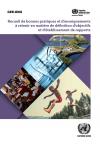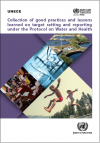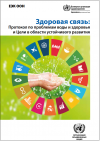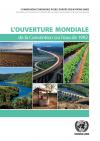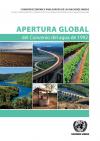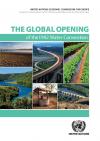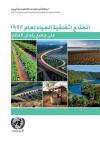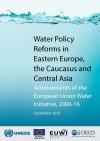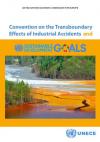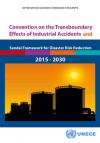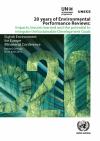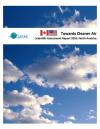Publications
Displaying Results 201 - 220 of 891
- English
The document aims to provide Parties with guidance in identifying the best abatement options for mobile emission sources, with particular reference to best available techniques, so as to assist them in meeting the obligations of the 1999 Protocol to Abate Acidification, Eutrophication and Ground-level Ozone.English
- English
This report provides an overview of hazard rating systems used by competent authorities in various UNECE member States for prioritising resources and directing attention to chemical hazard sites and industries where it is most needed. The report describes each system without attempting to analyse or compare differences or similarities. The purpose of the report is to give countries insight
- English
The checklist for contingency planning for accidents affecting transboundary waters was prepared by the Joint Ad Hoc Expert Group on Water and Industrial Accidents, following a decision by theConference of the Parties to the Convention on the Transboundary Effects of Industrial Accidents (Industrial Accidents Convention) at its sixth meeting (The Hague, 8–10 November 2010) and theMeeting of
- Français
The objective of the Collection of good practices and lessons learned on target setting and reporting under the Protocol on Water and Health is to provide concrete advice to countries planning to embark on the process of setting, revising or implementing targets, and reporting on the progress achieved in accordance with the Protocol.
In 2010,
- English
The objective of the Collection of good practices and lessons learned on target setting and reporting under the Protocol on Water and Health is to provide concrete advice to countries planning to embark on the process of setting, revising or implementing targets, and reporting on the progress achieved in accordance with the Protocol.
In 2010,
- Pусский
The Guidance Note on the development of action plans aims to help countries in translating the priorities identified through the self-assessment into actions. Specific Equitable Access Action Plans are needed to guide country (or sub-national entity) efforts to achieve equitable access to water and sanitation by identifying priority actions to be implemented and ways of implementing them. The
- Français
The Guidance Note on the development of action plans aims to help countries in translating the priorities identified through the self-assessment into actions. Specific Equitable Access Action Plans are needed to guide country (or sub-national entity) efforts to achieve equitable access to water and sanitation by identifying priority actions to be implemented and ways of implementing them. The
- English
The Guidance Note on the development of action plans aims to help countries in translating the priorities identified through the self-assessment into actions. Specific Equitable Access Action Plans are needed to guide country (or sub-national entity) efforts to achieve equitable access to water and sanitation by identifying priority actions to be implemented and ways of implementing them. The
- Pусский
Water, sanitation and health are at the core of the 2030 Agenda for Sustainable Development.The 1999 Protocol on Water and Health is a powerful tool to promote and operationalize the achievement of the 2030 Agenda and its Sustainable Development Goals. With its strong integrated and intersectoral approach, its focus on prevention and on the whole water cycle and its attention to safety and
- English
Water, sanitation and health are at the core of the 2030 Agenda for Sustainable Development.The 1999 Protocol on Water and Health is a powerful tool to promote and operationalize the achievement of the 2030 Agenda and its Sustainable Development Goals. With its strong integrated and intersectoral approach, its focus on prevention and on the whole water cycle and its attention to safety and
- Français
La Convention sur la protection et l’utilisation des cours d’eau transfrontières et des lacs internationaux (Convention sur l’eau) a été adoptée en 1992 et est entrée en vigueur en 1996. Elle rassemble presque tous les pays partageant des eaux transfrontières dans la région paneuropéenne et devrait parvenir à une plus large participation grâce à l’ouverture mondiale à tous les Etats membres des
- Español
El Convenio sobre la protección y utilización de los cursos de agua transfronterizos y de los lagos internacionales (Convenio del Agua) fue adoptado en 1992 y entró en vigor en 1996. Reúne casi todos los países que compar- ten aguas transfronterizas en la región paneuropea y se espera que alcance una participación más amplia con la apertura global a todos los Estados Miembros de las Naciones
- English
The Convention on the Protection and Use of Transboundary Watercourses and International Lakes (Water Convention) was adopted in 1992 and entered into force in 1996. It brings together almost all countries sharing transboundary waters in the pan-European region, and is expected to achieve broader participation with its global opening to all United Nations Member States.
The Water Convention
- العربية
The Convention on the Protection and Use of Transboundary Watercourses and International Lakes (Water Convention) was adopted in 1992 and entered into force in 1996. It brings together almost all countries sharing transboundary waters in the pan-European region, and is expected to achieve broader participation with its global opening to all United Nations Member States.
The Water Convention
- English
The brochure highlights the main outcomes of the EU Water Initiative (EUWI) contributions in the EECCA countries. Section 2 highlights specific achievements at a country level
in the context of national policy dialogues facilitated by the OECD and UNECE. Section 3 focuses on water diplomacy, highlighting progress in the context of transboundary water management and the regional dimension of the
- English
Convention on the Transboundary Effects of Industrial Accidents and the Sustainable Development Goals (postcard)
August 2016
Industrial accidents can happen anywhere, anytime. Often, they have severe consequences on human health and the environment, including in other affected countries. The UNECE Industrial Accidents Convention helps its Parties to prevent industrial accidents, especially those
- English
Convention on the Transboundary Effects of Industrial Accidents and the Sendai Framework for Disaster Risk Reduction (postcard)
August 2016
Industrial accidents can happen anywhere, anytime. Often, they have severe consequences on human health and the environment, including in other affected countries. The UNECE Industrial Accidents Convention helps its Parties to prevent industrial accidents,
- English
For over 20 years the Environmental Performance Review (EPR) Programme has contributed to the improvement of environmental management and performance of more than 20 member states of the United Nations Economic Commission for Europe (UNECE). The voluntary EPRs have analysed countries’ progress and challenges in meeting environmental targets and commitments and promoted information exchange among




